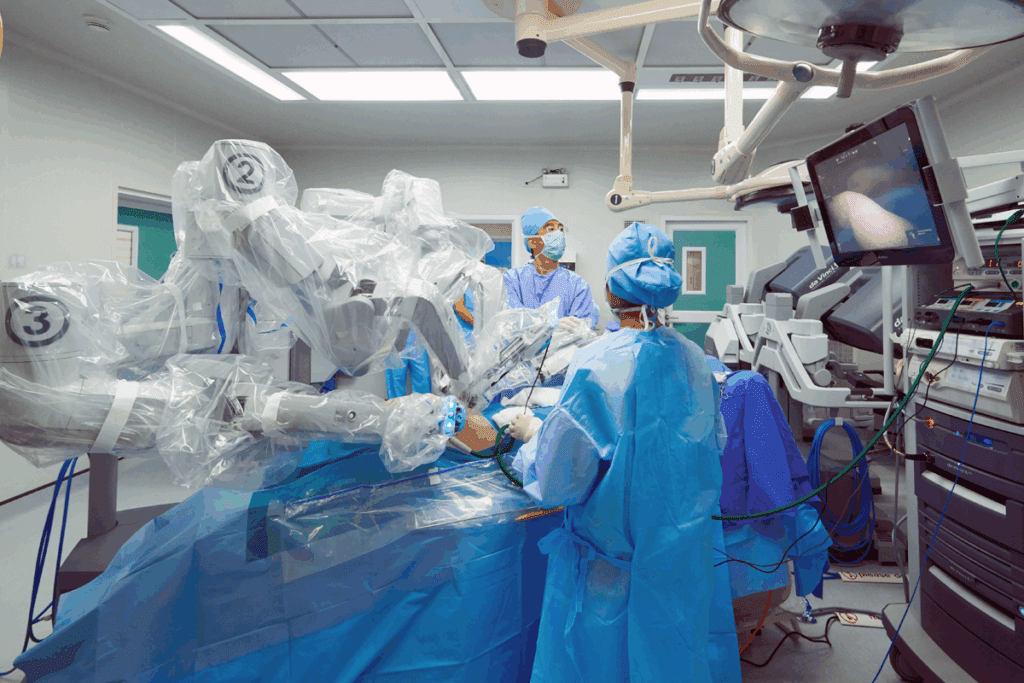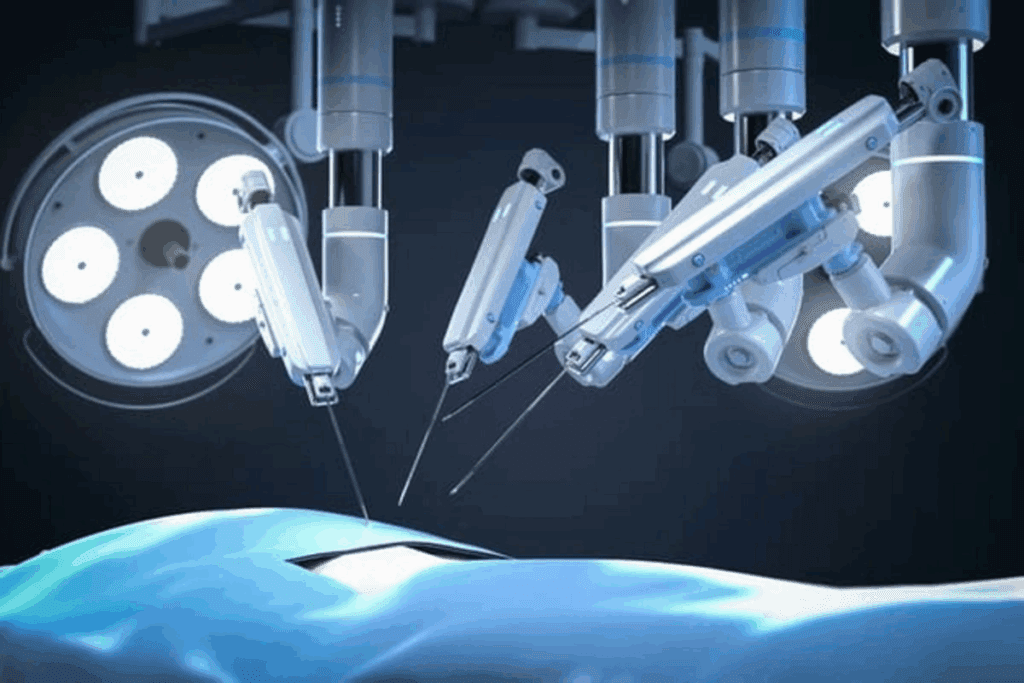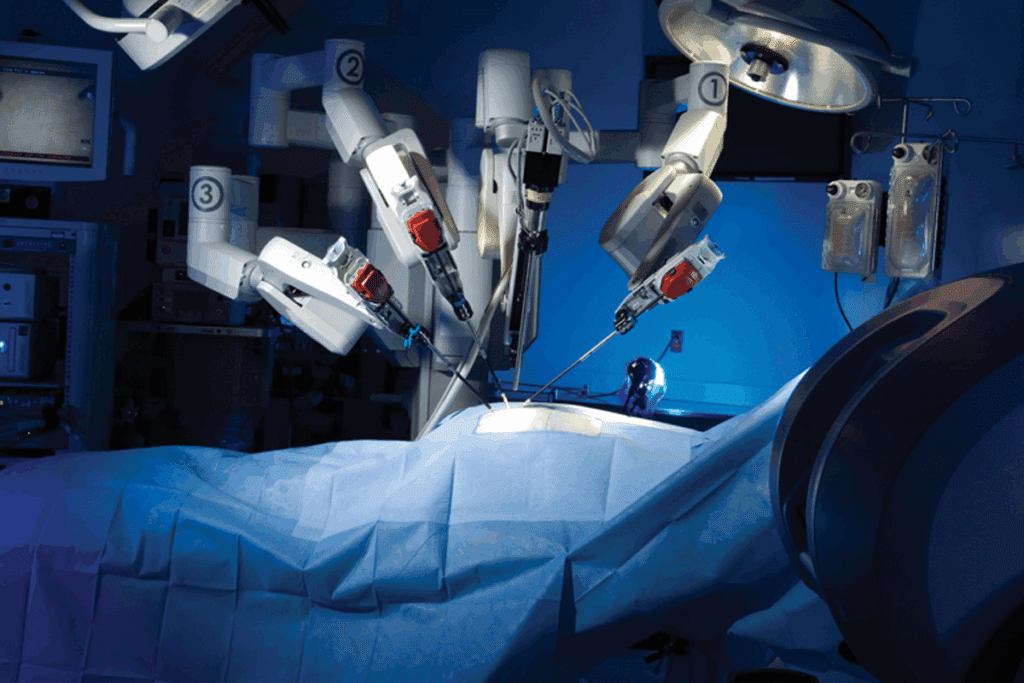Last Updated on November 27, 2025 by Bilal Hasdemir

Did you know over 500,000 coronary artery bypass grafting (CABG) procedures happen every year in the U.S.? Robotic heart surgery is changing how these surgeries are done. It offers a minimally invasive alternative to the old open-heart surgery ways.
This new surgical method lets a surgeon control robotic arms through small cuts. This cuts down on the harm to the patient and helps them heal faster. Knowing who can get this surgery helps patients make better choices for their heart health.

Cardiac surgery has changed a lot with robotic-assisted techniques. Robotic heart surgery is now a precise and less invasive option. It’s a big change from the old open-heart surgery.
Robotic-assisted cardiac surgery uses advanced robotic systems, like the da Vinci Surgical System. These systems help surgeons do complex heart surgeries through small incisions. This makes the surgery more precise and less harmful to the patient.
The da Vinci Surgical System lets surgeons work through tiny incisions between the ribs. This method cuts down on scarring and helps patients recover faster. The system’s tools give enhanced dexterity and visualization, making it possible to do more complex surgeries robotically.
Robotic heart surgery has grown a lot in the last 20 years. It started with simple surgeries but now includes totally endoscopic coronary artery bypass (TECAB) and robotic coronary bypass. This shows how robotic technology keeps getting better and improving heart care.
Robotic technology in cardiac surgery is a big leap forward in treating heart disease. As it keeps getting better, it will likely play a bigger role in heart care.

Robotic heart surgery has changed how we treat heart conditions. It offers precise and less invasive care. This makes it a top choice for many patients.
Robotic heart bypass surgery is key for treating coronary artery disease. This disease happens when arteries narrow or block, cutting off heart blood flow. Robotic surgery does bypass grafting with small cuts, cutting down recovery time.
Mitral valve issues, like mitral regurgitation, are treated with robotic cardiothoracic surgery. The mitral valve keeps blood flow right between heart chambers. Robotic surgery lets surgeons fix or replace it with great precision and less invasion.
Atrial septal defects (ASDs) are also treated with heart robotic surgery. ASDs have an opening in the heart’s upper chambers, letting blood leak. Robotic surgery closes these defects with little scarring and quick recovery.
Robotic surgery also helps with atrial fibrillation and some congenital heart defects. Robotic systems give surgeons better dexterity and vision for complex procedures.
| Cardiac Condition | Robotic Surgery Benefits |
| Coronary Artery Disease | Precise bypass grafting, smaller incisions |
| Mitral Valve Disorders | Precise repair or replacement, minimal invasion |
| Atrial Septal Defects | Minimal scarring, faster recovery |
As robotic surgery for heart conditions grows, more people benefit. This technology is shaping the future of heart care with its precision and less invasive methods.
“The use of robotic systems in cardiac surgery represents a significant advancement in our ability to treat complex heart conditions with minimal invasion and faster recovery times.”
A Cardiac Surgeon
Patients with certain heart conditions and good health are best for robotic heart surgery. This surgery, done by the best robotic heart surgeons, has many benefits. It uses smaller cuts, causes less pain, and leads to faster recovery than traditional surgery.
Those looking into robotic heart surgery should be in good health overall. They should have a stable medical condition and no severe lung disease. A detailed medical history review and tests are needed to check if they’re a good fit for the surgery.
The shape of a patient’s heart is key in deciding if they can have robotic surgery. Conditions like coronary artery disease and mitral valve issues can be treated this way. The robot bypass surgery and robot heart surgery are great for certain heart shapes.
A patient’s body type and past surgeries matter too. Slender patients do better with robotic surgery because of smaller cuts. Past chest surgeries might make things harder, but skilled surgeons can handle it.
Age and other health issues are also looked at closely. Older patients or those with other health problems might face more risks. But, robotic surgery can be safer than traditional methods. The choice depends on the patient’s health and the surgery’s benefits.
In summary, being a good candidate for robotic heart surgery means having the right heart condition and good health. It also helps if your body type is right for the surgery. A detailed check by cardiac surgeons is key to decide if it’s the right choice.
Certain medical conditions may make robotic procedures a suitable choice for heart surgery. Robotic heart surgery has been increasingly used to treat various cardiac conditions. It offers benefits like reduced recovery time and minimal scarring.
Patients with single or double vessel coronary disease may be ideal candidates for robotic coronary artery bypass surgery (CABG). This condition involves blockage in one or two coronary arteries. Robotic CABG can help restore blood flow to the heart.
Mitral valve regurgitation occurs when the mitral valve does not close properly, causing blood to leak backward. Robotic surgery can be used to repair or replace the mitral valve. This improves heart function and reduces symptoms.
Atrial fibrillation is a type of irregular heartbeat that can increase the risk of stroke and heart failure. Robotic surgery can be used to perform ablation procedures. These help restore a normal heart rhythm.
Congenital heart defects are structural problems in the heart that are present at birth. Robotic surgery can be used to repair certain types of congenital heart defects, such as atrial septal defects.
When considering robotic heart surgery, it’s essential to weigh the pros and cons of robotic surgery. While robotic surgery offers several benefits, including reduced recovery time and minimal scarring, it’s important to discuss the risks and benefits with a cardiac surgeon.
Robotic heart surgery has made big strides, but it’s not perfect. It’s great for many, but some patients might not be good candidates. This is due to certain health issues or cardiac problems.
Those with complex multi-vessel disease might not be right for robotic surgery. Their condition is often too complex. So, a traditional open-heart surgery is usually needed for a full treatment.
Severe calcification in arteries or valves can stop robotic surgery. The hard structures make it hard for the robotic tools to move well.
Complications from past chest surgeries can also be a problem. Adhesions or scar tissue can make it hard for the surgeon to use the robotic tools safely.
In emergencies, robotic heart surgery might not be the best choice. It takes time to set up, which can delay treatment. This makes it less ideal for urgent cases.
It’s important to know when robotic heart surgery is not a good fit. This decision is complex. It involves looking at the benefits and risks and considering other treatment options.
To qualify for robotic heart surgery, patients must go through a detailed evaluation. This includes various diagnostic tests and consultations. It’s key to check if a patient is right for robotic cardiac procedures.
The first step is a series of tests to check the heart’s health. These tests are echocardiograms, stress tests, and coronary angiography. These help doctors see if robotic surgery is the best choice.
Meeting with cardiac surgeons is a big part of the process. They look at the patient’s medical history and talk about the surgery’s benefits and risks. It’s also a chance for patients to ask questions and understand what to expect.
Doctors also do a detailed risk assessment. They look at the patient’s health and the heart condition’s complexity. This helps surgeons prepare and take steps to avoid complications.
Getting a second opinion is encouraged if patients are unsure. It can offer more insights and help in making a decision. It’s important to talk about the robotic heart surgery cost and insurance with the healthcare provider.
The evaluation for robotic heart surgery aims to find the best treatment. A thorough assessment means patients can get the most from robotic surgery. This could lead to faster recovery and better results.
Robotic-assisted cardiac surgery offers many benefits for those who qualify. It means less time recovering and less scarring. This method uses robotic technology for precise surgery, helping those with certain heart issues.
One big plus of robotic heart surgery is the shorter recovery time. It’s less invasive, so there’s less damage to tissues. This leads to faster healing and getting back to normal life sooner.
Robotic heart surgery uses smaller cuts than traditional surgery. This means less scarring. It also lowers the chance of problems with the wound.
The precision of robotic systems can lower the chance of problems during and after surgery. This includes less risk of bleeding, infection, and other issues.
Robotic technology gives surgeons better vision and control. This means they can do complex surgeries more accurately. It can lead to better results for patients in the long run.
| Benefit | Description |
| Reduced Recovery Time | Less invasive, leading to quicker healing |
| Minimal Scarring | Smaller incisions reduce scarring and wound complications |
| Lower Risk of Complications | Precision reduces risk of bleeding, infection, and other adverse events |
| Improved Precision and Outcomes | Enhanced visualization and dexterity improve long-term outcomes |
Knowing these benefits helps patients make better choices. Robotic heart surgery, like robotic CABG surgery, is a big step forward in heart care.
Traditional open heart surgery is being compared to robotic cardiac surgery. We look at how well each method works and how patients recover. It’s about understanding the differences and benefits of each approach.
Open heart surgery needs a big cut in the chest to reach the heart. Robotic surgery for heart bypass uses small cuts and a robotic system. It might cause less damage than traditional surgery.
Both non-robotic and robotic methods aim to make surgery less invasive. Robotic cardiothoracic surgery gives more precision and control. This could mean less damage and fewer complications.
Recovery times vary between traditional and robotic surgeries. Robotic surgery often means less pain, smaller scars, and a faster return to daily life.
Studies on the long-term effects of robotic heart transplant and other surgeries are ongoing. Early results show robotic surgery might have better long-term results than traditional methods.
| Aspect | Traditional Cardiac Surgery | Robotic Cardiac Surgery |
| Incision Size | Large incision | Several small incisions |
| Recovery Time | Typically longer | Generally shorter |
| Pain Level | More pain | Less pain |
| Scarring | Significant scarring | Minimal scarring |
Robotic heart surgery offers many benefits but comes with costs. The price can change based on the surgery’s complexity, the surgeon’s skill, and the hospital’s fees.
The cost of robotic heart surgery is often higher than traditional surgery. This is because of the advanced technology used. Yet, the cost can be lower due to shorter hospital stays and quicker recovery times.
In the United States, many insurances cover robotic heart surgery. But, the level of coverage can differ. It’s key for patients to check their insurance benefits and any costs they might have to pay.
Here is a breakdown of typical costs and insurance coverage:
| Procedure Aspect | Average Cost | Insurance Coverage |
| Surgeon’s Fee | $5,000 – $10,000 | Partially Covered |
| Hospital Stay | $20,000 – $50,000 | Majority Covered |
| Robotic Equipment | $3,000 – $5,000 | Varies by Provider |
Patients should ask about their coverage details. This includes:
For those facing financial hurdles, help is available. This includes hospital aid, non-profit groups, and government aid.
It’s important to understand the financial side of robotic heart surgery. Patients should talk to their healthcare team and insurance about their financial worries. This way, they can make a well-informed choice.
Robotic heart surgery is now a good choice for some patients. We’ve looked at the good points, who it’s for, and how to decide if it’s right for you.
People with heart issues like blocked arteries, mitral valve problems, and holes in the heart might benefit. The latest in robotic tech means better results and less time recovering. This makes it a great choice for those wanting less invasive surgery.
Before deciding on robotic heart surgery, talk to skilled heart doctors. They’ll check your health, heart shape, and other things to suggest the best treatment.
Knowing the pros and cons of robotic cardiac surgery helps you choose wisely. It’s a big step towards a better health outcome.
Robotic heart surgery is a new way to do heart surgery. It uses a robotic system, like the da Vinci Surgical System. This helps surgeons be more precise and recover faster.
Robotic heart surgery has many benefits. It means less time recovering, less scarring, and fewer complications. It also leads to better results than traditional surgery.
Robotic surgery can help with many heart problems. This includes coronary artery disease, mitral valve issues, and some congenital heart defects.
The right person for robotic heart surgery has a specific heart condition. They should be in good health and have conditions like single or double vessel coronary disease.
Some people can’t have robotic heart surgery. This includes those with complex heart disease, severe calcification, or previous chest surgery problems.
To see if you’re a good candidate, you’ll go through a detailed evaluation. This includes tests, talking to surgeons, and considering second opinions.
Robotic heart surgery is less invasive than traditional surgery. It means less recovery time and fewer complications. But, it depends on your specific situation.
The cost of robotic heart surgery varies. In the U.S., insurance may cover it. Always check with your insurance and ask about financial help if needed.
The da Vinci Surgical System is a key tool in robotic heart surgery. It offers clear 3D views and precise tools. This makes complex surgeries possible with less invasion.
Like any surgery, robotic heart surgery has risks. These include risks from the technology and the surgery itself. Your surgeons will discuss these during your consultation.
Yes, robotic heart surgery can be used for CABG. It’s a less invasive option for single or double vessel coronary disease.
Recovery from robotic heart surgery is usually faster than traditional surgery. Most people can get back to normal in a few weeks.
Subscribe to our e-newsletter to stay informed about the latest innovations in the world of health and exclusive offers!